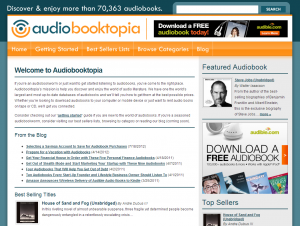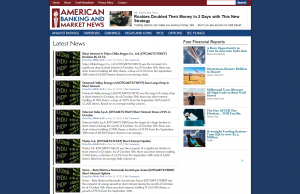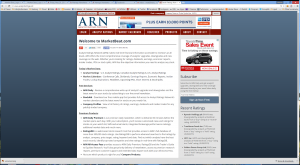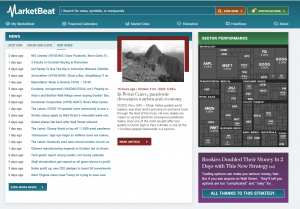The setting is Thanksgiving of 2010. Karine and I were engaged at the time and were planning a wedding the following summer. We spent the long weekend at her parents’ farm outside of Emery, South Dakota. The weekend was marked by energetic nieces and nephews, board games, walks on country roads and German chocolate pie. Our own children were still a couple of years away from being born. At the time, I had a day job doing website development work. In my free time, I was trying to build a mini conglomerate of online businesses so that I could one day be self-employed.

My online business efforts were about four years old at this point. I had achieved moderate success by running a few different internet business concepts. I launched an online directory of audiobooks called Audiobooktopia and a WordPress optimization service called WPMechanic. I was also doing freelance web design work under the moniker Matthew Paulson Consulting, but my most successful online endeavor at the time was a blog called American Consumer News.
American Consumer News featured personal finance news and advice and was written by me and a team of freelance writers. It was monetized using Google Adsense and by selling links to other publishers to improve their search engine rankings. It had grown to nearly six-figures in revenue in 2010, but each month was a struggle. Various Google algorithm updates and changes to social bookmarking websites made it harder and harder to attract new website visitors each month. The final nail in the coffin for American Consumer News was the first “Google Panda” algorithm update that launched in February 2011, but even the Thanksgiving before, I knew something had to change.
Introducing American Banking News.
My early entrepreneurial years involved throwing a lot of ideas at the wall hoping that something would stick. Many ideas simply failed due to poor marketing and execution. Others generated between $1,000 and $5,000 in revenue per month, but nothing took off in a major way until I launched a website called American Banking and Market News. It was (and still is) a website that publishes news about publicly traded companies with a specific focus on the finance sector. I launched American Banking and Market News in 2009, but it really started to take off in 2010 as it was accepted for inclusion in Google’s news index. The site’s inclusion in Google News allowed it to get referral traffic from news snippets in search results, Google News and Google Finance.

I hired a team of freelance writers to run American Banking News and was able to grow it to about 200,000 pageviews each month by Fall 2010. We would write dozens of breaking news articles each day hoping to be featured prominently in Google’s news section. We would also write a lot of articles, such as reporting on quarterly earnings or stock analysts’ buy recommendations, that followed a standardized layout. Eventually we got so good at writing these formulaic articles, that we could put out as many of 30 of them each day by looking up the data on Yahoo Finance and using macro’s to quickly create an article. It worked well enough, but it was a very manual process that was not scalable.
Million-Dollar Idea #1: The Birth of Automated Financial News
Back to Thanksgiving 2010, I found myself writing news articles on Black Friday and thought there had to be a better way to report on earnings announcements, insider transactions, dividend declarations and the like. When other people were playing games and watching Christmas movies, I was churning out content hoping to get a few dollars closer to the dream of self-employment. That’s when the first “million-dollar idea” hit me.
I realized that I could take the programming skills that I had picked up on my day job, merge it with the streamlined process I had used to publish content on American Banking News and create a an automated software algorithm that would publish financial news. I would purchase structured financial data from companies like Zacks, Quandl, and Barchart, run it through a relatively simple algorithm to create an article, and publish the generated article to our WordPress-based website using a technology called XML-RPC. I spent the rest of that weekend creating some proof of concept code and sure enough, it worked.
Here is an example of the type of content our algorithm would create:
Zacks Investment Research upgraded shares of Mercer International (NASDAQ:MERC) (TSE:MRI.U) from a hold rating to a buy rating in a report published on Saturday. The brokerage currently has $7.00 price target on the basic materials company’s stock.
According to Zacks, “Mercer International Inc. owns and operates a diverse pulp and paper business in the southern German states of Saxony and Thuringia, in the former East Germany. The Company operates it’s pulp business primarily through its subsidiaries, Spezialpapierfabrik Blankenstein GmbH and Zellstof-und Papierfabrik Rosenthal GmbH & Co. KG , and conducts its paper business through another subsidiary, Dresden Papier GmbH. “
Other research analysts have also recently issued research reports about the stock. Royal Bank of Canada cut their price objective on shares of Mercer International from $9.00 to $8.00 and set a sector perform rating on the stock in a research report on Monday, August 3rd. TD Securities cut their price target on shares of Mercer International from $9.00 to $8.50 and set a hold rating on the stock in a report on Tuesday, August 4th. BidaskClub downgraded shares of Mercer International from a sell rating to a strong sell rating in a research note on Saturday, September 12th. CIBC upgraded Mercer International from a neutral rating to a sector outperform rating and boosted their target price for the company from $9.00 to $10.00 in a research report on Tuesday, August 25th. Finally, Raymond James increased their price target on Mercer International from $10.00 to $11.00 and gave the stock an outperform rating in a report on Friday. One investment analyst has rated the stock with a sell rating, three have assigned a hold rating and four have assigned a buy rating to the company’s stock. The company has an average rating of Hold and a consensus price target of $9.42.
Mercer International stock opened at $6.29 on Friday. The company has a quick ratio of 2.65, a current ratio of 3.98 and a debt-to-equity ratio of 2.33. Mercer International has a twelve month low of $5.77 and a twelve month high of $13.44. The company’s 50-day moving average price is $6.72 and its 200-day moving average price is $7.82. The company has a market cap of $414.31 million, a PE ratio of -4.95 and a beta of 1.78.
While the technical underpinnings of our article creation algorithms are not especially technically complicated, we were the first people to combine structured financial data, natural language generation (NLG) technology and publish the resulting articles to a news website. Three years after we started publishing earnings reports and other articles using NLG technology, the Associated Press followed in our footsteps and other competitors started using similar technology. I can’t say with 100% certainty, but there is a strong chance that I created the first algorithm that wrote financial news content.
My invention of automated financial content was the first idea that really propelled MarketBeat’s early growth and success. I was able to reduce the company’s writing costs to near zero and significantly increase the volume of content produced. This allowed MarketBeat’s news sites, including American Banking News, to quickly ramp up to over 1 million pageviews per month a year later. By the time the strategy stopped working in early 2020, we had gotten nearly 200 million visitors referred by Google News, Bing News and Yahoo News to our automated articles. Building an automated content engine was a huge win, but there was another piece of the puzzle that MarketBeat still needed.
Million Dollar Idea #2: Launching the MarketBeat Newsletter
I knew from the beginning that MarketBeat’s automated content strategy would not work forever. At minimum, others would try to copy MarketBeat (they did) and Google’s algorithm would change over time (it did). Given that my unique search engine optimization (SEO) strategy had an unknown shelf-life, I needed to capture the contact information of as many people that visited my websites as possible. That way if Google ever stopped sending web traffic, I would still be able to market to people that visited MarketBeat’s website previously.
One of the lessons I learned from listening to the Internet Business Mastery podcast was that to succeed in online business you need to identify a niche audience and hyper serve them with products and services that were created just for them. The hosts, Jason and Jeremy, hammered home the idea that you need to build an audience in a specific niche, that you need to have products to sell them and that you can’t just have a website monetized by advertisements. I decided I was going to take their advice and build a product that served individual stock investors.

As a first attempt, I decided to launch a free daily email newsletter that would send out new buy and sell ratings from stock analysts each day. We were already collecting analysts’ ratings for our reporting each day, so compiling that data into an email newsletter and sending it out was a straightforward technical challenge. Initially we collected email signups under a new brand called Analyst Ratings Network (which we would later rebrand to MarketBeat).
For the first eighteen months, we did not make any money from our free daily newsletter. After we reached what I thought to be a critical mass of subscribers (about 25,000 at the time), I decided it was time to try to sell them something. I surveyed our subscribers, asking them what they liked about the newsletter and what they thought could be improved. I took their feedback and used it to create a premium version of the newsletter that was available for $20.00 per month. MarketBeat had a mere 100 subscribers by the end of 2011, but I had the beginnings of a scalable business model. Eventually, MarketBeat would come to have more than 10,000 premium subscribers and make millions by marketing to its email list. The combination of publishing automated financial content and building a financial audience on email were the two key elements to turn MarketBeat into the business that it is today.
MarketBeat’s Decade of Growth
Like most entrepreneurs, I did a lot of things wrong early on and missed some of the key components that would later make my business successful. I frequently got distracted by new ideas that took my focus away from MarketBeat. I held onto my day job about a year long than I should have. I didn’t have good error correction code in place, which led to a couple of cease and desist letters from publicly traded companies and an unfortunate phone call with the Securities and Exchange Commission. I had websites that got penalized by search engines for being a bit too aggressive with automated content. I managed to grow the business every year, but it wasn’t without taking a lot of bumps and bruises along the way.
Thankfully, I had several key “ah ha” moments over the years that fueled MarketBeat’s growth. After quitting my day job in late 2012, I was able to put 100% of my best mental energy into my business. I learned that our email list was an incredibly valuable marketing tool for other financial advertisers in 2014, which created a substantial new revenue stream in the business. Overtime, I learned the value of having a team and slowly brought on employees. I learned that MarketBeat could replicate the success it had with email on other platforms, such as browser notifications, SMS and Facebook groups. By 2014, MarketBeat had its first million-dollar year in revenue.
Over the last five years, our business model has not changed. We continue to be the digital equivalent of financial newspaper, selling both advertising and premium subscriptions to our end users. Email continues to be our primary communication tool with our subscribers, but our automated news content strategy has largely come and gone. Instead, we have diversified and found new ways to attract email subscribers through paid advertising channels and other means. Our goal is largely to do the same thing a little bit better each year.
Today and the Future

The end of 2020 marks MarketBeat’s 10th birthday. Today, we describe MarketBeat as a financial media company that provides stock market news, information, and research tools to individual investors. Our company has nine employees spread across four states, a team of eight freelance writers and a handful of contractors that provide the company other professional services. The MarketBeat website attracts between 10 and 15 million pageviews each month. Our newsletters have a combined 1.8 million subscribers, and we have sent out more than 1.2 billion emails in 2020. We will end 2020 north of more than $10 million in annual revenue and anticipate continued growth in 2021.
What is next for MarketBeat? Well, a lot more of the same. We have a business model that generates a healthy profit and continues to grow year-after-year. I feel no pressure to sell the business given that I am relatively young (I am 35), there are no existential headwinds that are likely to threaten the business’s viability, and we have no need for outside capital. If I run MarketBeat for another 15 years, grow it by about 10% per year, and retire around age 50 to focus on charitable and community projects, I will consider that a successful career. We have a great team that enjoys working together, I just hope to keep the ride going as long as we can.
Happy 10th Birthday, MarketBeat!
